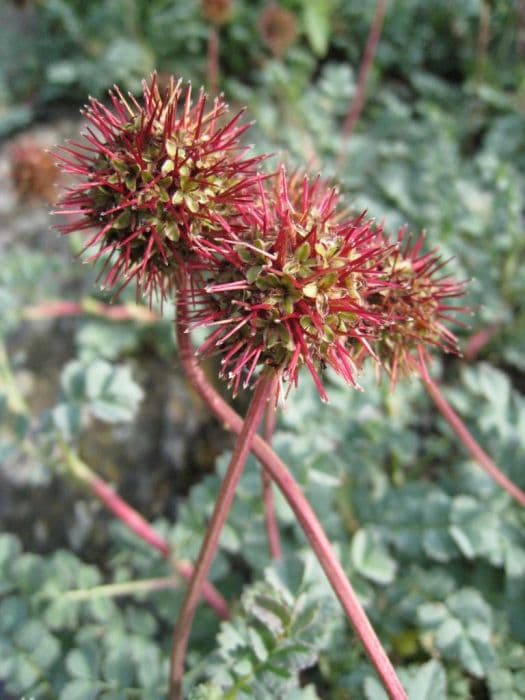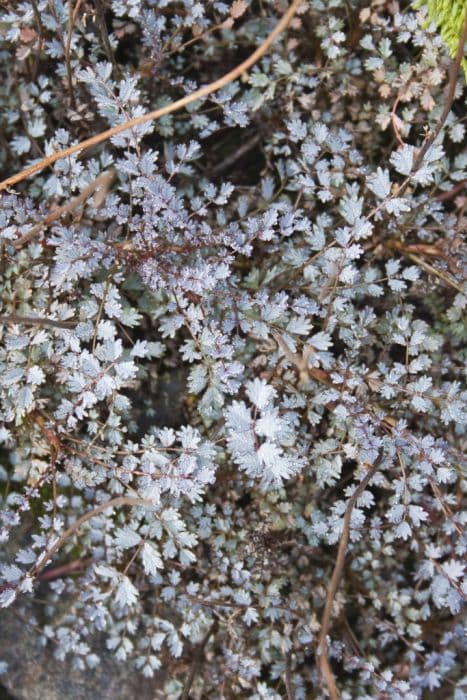Rowan Sorbus hemsleyi 'John Bond'

ABOUT
Sorbus hemsleyi 'John Bond', commonly known as the Mountain Ash or Rowan, has a rich tapestry of features that come together to form an attractive ornamental tree. Despite not delving into its dimensions, one can appreciate the distinctive attributes that this tree exhibits throughout the seasons. The most striking feature is its foliage which is pinnate—meaning the leaves are comprised of multiple leaflets arranged on either side of a central stem. The leaves are a fresh green color during the growth season and turn to vivid shades of red and orange in the fall, providing a spectacular autumn display. With each leaflet being finely toothed or serrated at the edges, there is a lovely texture to the foliage. Spring introduces clusters of small, white, five-petaled flowers that bloom and emanate a charming fragrance. These are not to be overshadowed by the autumn display, where clusters of round berries take center stage. These berries often start a lighter color, and as the season progresses, they deepen into a rich red or orange, providing food for birds and a splash of color for the eye. The bark of 'John Bond' is also noteworthy, being smooth with a silvery-grey appearance that can provide visual interest even in the winter months when the leaves have fallen. Overall, the Sorbus hemsleyi 'John Bond' is appreciated for its seasonal changes, showy fruits, and attractive blooms, making it a beloved addition to any garden or landscape where its beauty can be admired without scale.
About this plant
 Names
NamesFamily
Rosaceae.
Synonyms
Hemsley's Rowan, Hemsley Mountain Ash, John Bond Rowan.
Common names
Sorbus hemsleyi 'John Bond'.
 Toxicity
ToxicityTo humans
The Mountain Ash, specifically the Sorbus hemsleyi 'John Bond', is not commonly known for being toxic to humans. However, excessive consumption of the berries by children may lead to mild stomach upset. It is always advisable to exercise caution and not consume parts of ornamental plants due to potential individual allergies or unknown reactions.
To pets
The Mountain Ash, including the Sorbus hemsleyi 'John Bond', is generally not considered toxic to pets such as dogs and cats. While the fruit may be eaten by wildlife, domestic pets should not be encouraged to eat the berries, as they might cause mild gastrointestinal upset if consumed in large quantities. It is always best to prevent pets from ingesting plants not intended for consumption to avoid any potential health issues.
 Characteristics
CharacteristicsLife cycle
Perennials
Foliage type
Deciduous
Color of leaves
Varies
Flower color
White
Height
20 feet (6 meters)
Spread
15 feet (4.5 meters)
Plant type
Tree
Hardiness zones
6
Native area
China
Benefits
 General Benefits
General Benefits- Ornamental Appeal: Adds visual interest to gardens with its vibrant foliage and seasonal changes.
- Habitat for Wildlife: Provides food and shelter for birds and beneficial insects.
- Drought Resistance: Adapted to survive in periods of low rainfall once established, reducing the need for irrigation.
- Low Maintenance: Requires minimal upkeep when compared to other garden plants.
- Tolerance to Cold: Can withstand cooler temperatures, making it suitable for a range of climates.
- Autumn Color: Offers striking autumnal color change in leaves, contributing to landscape aesthetics.
- Non-Invasive: Unlike some ornamental plants, it typically doesn't spread uncontrollably, so it won't disrupt local ecosystems.
 Medical Properties
Medical PropertiesThis plant is not used for medical purposes.
 Air-purifying Qualities
Air-purifying QualitiesThis plant is not specifically known for air purifying qualities.
 Other Uses
Other Uses- Wildlife habitat: Sorbus hemsleyi 'John Bond' provides shelter and nesting sites for birds and small mammals due to its dense foliage.
- Photography subject: The attractive features of the Mountain Ash, such as its white blossoms and red berries, make it a popular subject for nature photographers.
- Educational tool: The variety of features exhibited by the Mountain Ash throughout the seasons can be used to teach about plant life cycles and seasonal changes in nature.
- Culinary experimentation: While not commonly used in cooking, the tart berries can be used to make unique jellies or syrups by those interested in experimental foraging and cooking.
- Dye production: The berries of the Mountain Ash can be used to produce natural dyes for textiles, yielding colors that range from greens to purples depending on the mordant used.
- Artistic inspiration: Artists and craftsmen may draw inspiration from the striking autumn colors and overall form of the Mountain Ash for paintings, sculptures, or design work.
- Craft material: Thin, flexible branches may be harvested to create woven crafts like baskets or decorative wreaths.
- Companion planting: Due to its non-invasive root system, the Mountain Ash can be planted alongside other species without disrupting them, aiding in biodiversity.
- Ice cream flavoring: The berries can be infused into cream to create a unique, locally-sourced ice cream flavor, appealing to artisanal food makers.
- Urban green spaces: The Mountain Ash can be used in urban landscaping to provide greenery and improve aesthetics in city environments due to its moderate size and attractive appearance.
Interesting Facts
 Feng Shui
Feng ShuiThe Mountain Ash is not used in Feng Shui practice.
 Zodiac Sign Compitability
Zodiac Sign CompitabilityThe Mountain Ash is not used in astrology practice.
 Plant Symbolism
Plant Symbolism- Endurance: Sorbus hemsleyi, commonly known as the Mountain Ash or Rowan, is often associated with endurance due to its ability to grow in harsh conditions and withstand cold climates.
- Protection: In folklore, the Rowan tree is believed to ward off evil spirits, offering protection to those near it.
- Wisdom: With its longstanding presence in mythology, the Rowan is also connected with wisdom and is said to promote clear thinking.
- Healing: Sorbus species are sometimes linked with healing, both in a physical and spiritual sense, echoing the traditional use of its berries in folk medicine.
 Water
WaterThe Rowan tree should be watered deeply once a week during its first growing season to help establish a strong root system; this can be roughly equivalent to about 1-2 gallons depending on the soil and climate conditions. After establishment, it's less demanding but should be watered every two to three weeks with the same amount if there is no substantial rainfall. In hot and dry spells, water the same amount but increase the frequency to once a week. In winter, reduce watering since the tree is dormant and excess water could lead to root rot. Always ensure the soil is moist but not waterlogged.
 Light
LightThe Rowan tree prefers a position in full sun to partial shade. It thrives best in bright, direct sunlight for at least six hours a day, but can tolerate some light shade. Avoid deep shade positions as this can hinder its growth and fruit production.
 Temperature
TemperatureThe Rowan tree is hardy and can tolerate cold, withstanding temperatures as low as -20 to -30 degrees Fahrenheit. However, it grows best in temperate climates with an ideal temperature range of 50 to 70 degrees Fahrenheit. Extreme heat above 90 degrees Fahrenheit can stress the tree, so it's important to provide proper care during hot spells.
 Pruning
PruningPrune the Rowan tree in late winter to early spring before new growth begins, to remove any dead or diseased wood and to shape the tree. Thinning out crowded branches can improve air circulation and light access. It's usually sufficient to prune the tree every 2-3 years, but always remove damaged or broken limbs as soon as they are noticed.
 Cleaning
CleaningAs needed
 Soil
SoilRowan 'John Bond' prefers well-drained, loamy soil with a pH between 5.5 and 7.5. The best soil mix includes equal parts of garden soil, compost, and perlite or coarse sand to improve drainage.
 Repotting
RepottingRowan 'John Bond' should generally be repotted every 2 to 3 years, or when the roots outgrow the pot. Choose a pot with drainage holes that is slightly larger than the current one.
 Humidity & Misting
Humidity & MistingRowan 'John Bond' thrives in moderate humidity levels, often found in the average outdoor environment. There is no specific humidity requirement, but it should not be too dry.
 Suitable locations
Suitable locationsIndoor
Ensure bright, indirect light and cool temps.
Outdoor
Plant in well-drained soil, full sun to partial shade.
Hardiness zone
5-9 USDA.
 Life cycle
Life cycleSorbus hemsleyi 'John Bond,' commonly known as John Bond rowan, begins its life as a seed, which, once germinated, develops into a seedling with roots and shoots. As the plant matures, it progresses into a vegetative growth stage, forming a sturdy trunk, branches, and leaves. Following this, the rowan enters the flowering stage, producing clusters of white blossoms that are attractive to pollinators. After pollination, these flowers develop into small red or orange pome fruits, which can disperse seeds for reproduction. The plant reaches maturity once it is capable of flowering and fruiting annually. As a perennial, John Bond rowan can live many years, going through a continual cycle of seasonal growth, flowering, and fruiting until it reaches senescence and eventually dies.
 Propogation
PropogationPropogation time
Spring-Early Summer
Propogation: Sorbus hemsleyi 'John Bond', commonly known as Rowan or Mountain Ash, is often propagated by seeds, as this is the most popular method for many trees in the Sorbus genus. The best time to collect seeds is in autumn when the berries are ripe, typically from September to October. Seeds require stratification, which is a cold treatment to break dormancy and can be achieved by mixing them with moist sand and storing them in the refrigerator, at about 40 degrees Fahrenheit (4.4 degrees Celsius), for approximately 3 months. After stratification, the seeds are sown in a cold frame or a well-ventilated greenhouse in the spring. It's important to provide consistent moisture and protection from extreme temperatures as the seedlings develop. Once they reach a sufficient size and have hardened off, the young Rowan trees can be transplanted into their permanent positions in the garden or landscape.









